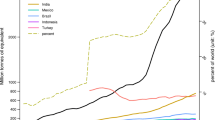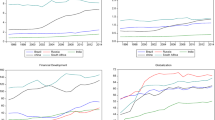Abstract
This study investigates the relationship between energy consumption and carbon dioxide emission in the causal framework, as the direction of causality remains has a significant policy implication for developed and developing countries. The study employed maximum entropy bootstrap (Meboot) approach to examine the causal nexus between energy consumption and carbon dioxide emission using bivariate as well as multivariate framework for Malaysia, over a period of 1975–2013. This is a unified approach without requiring the use of conventional techniques based on asymptotical theory such as testing for possible unit root and cointegration. In addition, it can be applied in the presence of non-stationary of any type including structural breaks without any type of data transformation to achieve stationary. Thus, it provides more reliable and robust inferences which are insensitive to time span as well as lag length used. The empirical results show that there is a unidirectional causality running from energy consumption to carbon emission both in the bivariate model and multivariate framework, while controlling for broad money supply and population density. The results indicate that Malaysia is an energy-dependent country and hence energy is stimulus to carbon emissions.





Similar content being viewed by others
Notes
NEBM (2009)
Besides CO2, some other gases such as monoxide, sulfur dioxide, etc. are also considered pollutant elements.
Mohamed and Lee (2006)
This group was founded in 1991 after the disbanding of the Communist Bloc and included the Czech Republic, Slovakia (after the disbanding of Czechoslovakia in 1992), Hungary, and Poland.
We estimated the system in (1) and (2) with p = 1 and p = 2, i.e., VAR(1), VAR(2)
We estimated the system in (1) and (2) with p = 1 and p = 2, i.e., VAR(1), VAR(2) model.
References
Acaravci A, Ozturk I (2010) On the relationship between energy consumption, CO2 emissions and economic growth in Europe. Energy 35(12):5412–5420
Acaravci A, Ozturk I (2012) Electricity consumption and economic growth nexus: a multivariate analysis for Turkey. Amfiteatru Econ J XIV(31):246–257
Akhmat G, Zaman K, Shukui T, Irfan D, Khan MM (2014) Does energy consumption contribute to environmental pollutants? Evidence from SAARC countries. Environ Sci Pollut Res 21(9):5940–5951
Al-Amin AQ, Siwar C, Jaafar AH (2009) Energy use and environmental impact of new alternative fuel mix in electricity generation in Malaysia. Open Renewable Energy J 2:25–32
Amin SB, Ferdaus SS, Porna AK (2012) Causal relationship among energy use, CO2 emissions and economic growth in Bangladesh: an empirical study. World J Social Sci 2(4):273–290
Ang JB (2007) CO2 emissions, energy consumption, and output in France. Energy Policy 5:4772–4778
Ang JB (2008) Economic development, pollutant emissions and energy consumption in Malaysia. J Policy Model 30(2):271–278
Apergis N, Payne JE (2009) CO2 emissions, energy usage and output in Central America. Energy Policy 37:3282–3286
Arouri M E H, Youssef A B, M’henni H, Rault C (2012) Energy consumption, economic growth and CO2 emissions in Middle East and North African Countries. Discussion Paper No. 6412, IZA, Bonn- Germany
Asafu-Adjaye J (2000) The relationship between energy consumption, energy prices and economic growth: time series evidence from Asian developing countries. Energy Econ 22(6):615–625
Azhar Khan M, Zahir Khan M, Zaman K, Naz L (2014) Global estimates of energy consumption and greenhouse gas emissions. Renew Sust Energ Rev 29:336–344
Azlina AA, Mustapha NHN (2012) Energy, economic growth and pollutant emissions nexus: the case of Malaysia. Procedia Social Behav Sci 65(3):1–7
Azlina AA, Law SH, Mustapha NHN (2014) Dynamic linkages among transport energy consumption, income and CO2 emission in Malaysia. Energy Policy 73:598–606
Begum RA, Sohag K, Abdullah SMS, Jaafar M (2015) CO2 emissions, energy consumption, economic and population growth in Malaysia. Renew Sust Energ Rev 41:594–601
Bekhet HA, Othman NS (2014) Long-run elasticities of electricity consumption, FDI, export and GDP in Malaysia. Int J Econ Finance 6(8):78–91
Bekhet HA, Yasmin T (2013) Disclosing the relationship among CO2 emissions, energy consumption, economic growth and bilateral trade between Singapore and Malaysia: an econometric analysis. Int J Social Manag Econ Business Eng 7(9):1263–1268
Central Intelligence Agency (CIA) (2014) The World Bank Fact Book. Retrieved from https://www.cia.gov/library/publications/the-world-factbook/rankorder/rankorderguide.html on 2 Nov 2014
Chang CC (2010) A multivariate causality test of carbon dioxide emissions, energy consumption and economic growth in China. Appl Energy 87(11):3533–3537
Cheng BS (1999) Causality between energy consumption and economic growth in India: an application of co-integration and error-correction modeling. Indian Econ Rev 34:39–49
Chik N A Rahim K A (2012) The impact of Malaysian industrial energy use on carbon dioxide emissions. 3rd International Conference on Business and Economic Research (3rd ICBER, 2012) Proceeding, 12–13 March 2012. Golden Flower Hotel, Bandung, Indonesia
Chong C, Ni W, Ma L, Liu P, Li Z (2015) The use of energy in Malaysia: tracing energy flows from primary source to end use. Energies 8(4):2828–2866
Colenbrander S, Gouldson A, Sudmant A H, Papargyropoulou E, Chau L W, Ho C S (2015) Exploring the economic case for early investment in climate change mitigation in middle-income countries: a case study of Johor Bahru, Malaysia. Climate and Development, (ahead-of-print), 1-14
Conceicao P (2003) Assessing the provision status of global public goods. In: Kaul I et al (eds) Providing global public goods: managing globalization. Oxford University Press, New- York
Dritsaki C, Dritsaki M (2014) Causal relationship between energy consumption, economic growth and CO2 emissions: a dynamic panel data approach. Int J Energy Econ Policy 4(2):125–136
Engle RF, Granger C (1987) Co-integration and error correction: representation, estimation, and testing. Econometrica 55:251–276
Esmaeilifar R, Samari M, Mirzaei NF, MohdShafiei MW (2015) How is electricity consumption on construction sites in Malaysia related to sources of CO2? Adv Environ Biol 9(5):160–163
Farhani S, Rejeb JB (2012) Energy consumption, economic growth and CO2 emissions: evidence from panel data for MENA region. Int J Energy Econ Policy 2(2):71–81
Halicioglu F (2009) An econometric study of CO2 emissions, energy consumption, income and foreign trade in Turkey. Energy Policy 37(3):1156–1164
Hwang JH, Yoo SH (2014) Energy consumption, CO2 emissions, and economic growth: evidence from Indonesia. Qual Quant 48(1):63–73
Hyndman RJ (1996) Computing and graphing highest density regions. Am Stat 50(2):120–126
Islam F, Shahbaz M, Ahmed AU, Alam MM (2013) Financial development and energy consumption nexus in Malaysia: a multivariate time series analysis. Econ Model 30:435–441
Johansen S, Juselius K (1990) Maximum likelihood estimation and inference on cointegration with applications to the demand for money. Oxf Bull Econ Stat 52(2):169–210
Keat S C, Chun B B, San L H, Jafri M Z M (2015, April) Multiple regression analysis in modelling of carbon dioxide emissions by energy consumption use in Malaysia. In National Physics Conference 2014 (PERFIK 2014) (Vol. 1657, p. 050005). AIP Publishing
Koutroumanidis T, Ioannou K, Arabatzis G (2009) Predicting fuel wood prices in Greece with the use of ARIMA models, artificial neural networks and a hybrid ARIMA-ANN model. Energy Policy 37(9):3627–3634
Kula F, Aslan A, Ozturk I (2012) Is per capita electricity consumption stationary? Time series evidence from OECD countries. Renew Sust Energ Rev 16(1):501–503
Lau LS, Choong CK, Eng YK (2014) Investigation of the environmental Kuznets curve for carbon emissions in Malaysia: do foreign direct investment and trade matter? Energy Policy 68:490–497
Lean HH, Smyth R (2010a) CO2 emissions, electricity consumption and output in ASEAN. Appl Energy 87(6):1858–1864
Lean HH, Smyth R (2010b) Multivariate Granger causality between electricity generation, exports, prices and GDP in Malaysia. Energy 35(9):3640–3648
Liu X (2005) Explaining the relationship between CO2 emissions and national income; the role of energy consumption. Econ Lett 87:325–328
Loganathan N, Subramaniam T (2010) Dynamic cointegration link between energy consumption and economic performance: empirical evidence from Malaysia. Int J Trade Econ Finance 1(3):261–267
Loganathan N, Shahbaz M, Taha R (2014) The link between green taxation and economic growth on CO2 emissions: fresh evidence from Malaysia. Renew Sust Energ Rev 38:1083–1091
Loron MS, Ismail S, Yunos MYBM (2015) Energy efficiency for reducing carbon footprint in historic buildings: comparing case in the UK and Malaysia. Advances in Environmental Biology 9(4):82–84
Magazzino C (2014) A panel VAR approach of the relationship among economic growth, CO2 emissions, and energy use in the ASEAN-6 countries. Int J Energy Econ Policy 4(4):546–553
Mensah JT (2014) Carbon emissions, energy consumption and output: a threshold analysis on the causal dynamics in emerging African economies. Energy Policy 70:172–182
Menyah K, Wolde-Rufael Y (2010) Energy consumption, pollutant emissions and economic growth in South Africa. Energy Econ 32:1374–1382
Mohamed AR, Lee KT (2006) Energy for sustainable development in Malaysia: energy policy and alternative energy. Energy Policy 34(2006):2388–2397
Mugableh MI (2013) Analysing the CO2 emissions function in Malaysia: autoregressive distributed lag approach. Procedia Econ Finance 5:571–580
NEBM (2009), National Energy Balance Malaysia 2009, Malaysian Green Technology Corporation, pp. 1-54
Ozturk I, Aslan A (2011) Are fluctuations in energy consumption per capita transitory? Evidence from turkey. Energy, Explor Exploit 29(2):161–168
Ozturk I, Salah Uddin G (2012) Causality among carbon emissions, energy consumption and growth in India. Ekonomska istraživanja 25(3):752–775
Pao H-T, Tsa C-M (2010) CO2 emissions, energy consumption and economic growth in BRIC countries. Energy Policy 38:7850–7860
Papiez M (2013) CO2 emissions, energy consumption and economic growth in the Visegrad Group countries: a panel data analysis. In: 31st International Conference on Mathematical Methods in Economics 2013., pp 696–701
Park SY, Yoo SH (2014) The dynamics of oil consumption and economic growth in Malaysia. Energy Policy 66:218–223
Payne J (2010) Survey of the international evidence on the causal relationship between energy consumption and growth. J Econ Stud 37(1):53–95
Saboori B, Sulaiman J, Mohd S (2012) Economic growth and CO2 emissions in Malaysia: a cointegration analysis of the environmental Kuznets curve. Energy Policy 51:184–191
Shaari MS, Hussain NE, Ismail MS (2012) Relationship between energy consumption and economic growth: empirical evidence for Malaysia. Business Syst Rev 2(1):17–28
Shahbaz M, Solarin SA, Mahmood H, Arouri M (2013) Does financial development reduce CO2 emissions in Malaysian economy? A time series analysis. Econ Model 35:145–152
Soytas U, Sari R (2009) Energy consumption, economic growth, and carbon emissions: challenges faced by an EU candidate member. Ecol Econ 68(6):1667–1675
Soytas U, Sari R, Ewing BT (2007) Energy consumption, income, and carbon emissions in the United States. Ecol Econ 62(3):482–489
Tang CF, Tan BW (2014) The linkages among energy consumption, economic growth, relative price, foreign direct investment, and financial development in Malaysia. Qual Quant 48(2):781–797
Tiwari AK (2011) Energy consumption, CO2 emissions and economic growth: a revisit of the evidence from India. Appl Econ Int Dev 1(1-2):165–189
Toda HY, Phillips PC (1993) Vector autoregressions and causality. Econometrica 61(6):1367–1393
Vinod HD, de Lacalle JL (2009) Maximum entropy bootstrap for time series: the meboot R package. J Stat Softw 29(5):1–19
Wahid IN, Aziz AA, Mustapha NHN (2013) Energy consumption, economic growth and CO2 emissions in selected ASEAN countries. Prosiding Perkem VIII(2):758–765
World Bank (2014) World development indicators. World Bank, Washington, D.C., USA
Xue B, Geng Y, Muller K, Lu C, Ren W (2014) Understanding the causality between carbon dioxide emission, fossil energy consumption and economic growth in developed countries: an empirical study. Sustainability 6:1037–1045
Yalta AT (2011) Analyzing energy consumption and GDP nexus using maximum entropy bootstrap: the case of Turkey. Energy Economics 33:453–460
Yalta AT, Cakar H (2012) Energy consumption and economic growth in China: A reconciliation. Energy Policy 41:666–675
Yang Z, Zhao Y (2014) Energy consumption, carbon emissions, and economic growth in India: evidence from directed acyclic graphs. Econ Model 38:533–540
Zhang XP, Cheng XM (2009) Energy consumption, carbon emissions, and economic growth in China. Ecol Econ 68(10):2706–2712
Zhao T, Ren X-s (2013) The empirical research of the causality relationship between CO2 emissions intensity, energy consumption structure, energy intensity and industrial structure in China. In: The 19th International Conference on Industrial Engineering and Engineering Management., pp 601–609
Author information
Authors and Affiliations
Corresponding author
Additional information
Responsible editor: Philippe Garrigues
Rights and permissions
About this article
Cite this article
Gul, S., Zou, X., Hassan, C.H. et al. Causal nexus between energy consumption and carbon dioxide emission for Malaysia using maximum entropy bootstrap approach. Environ Sci Pollut Res 22, 19773–19785 (2015). https://doi.org/10.1007/s11356-015-5185-0
Received:
Accepted:
Published:
Issue Date:
DOI: https://doi.org/10.1007/s11356-015-5185-0




